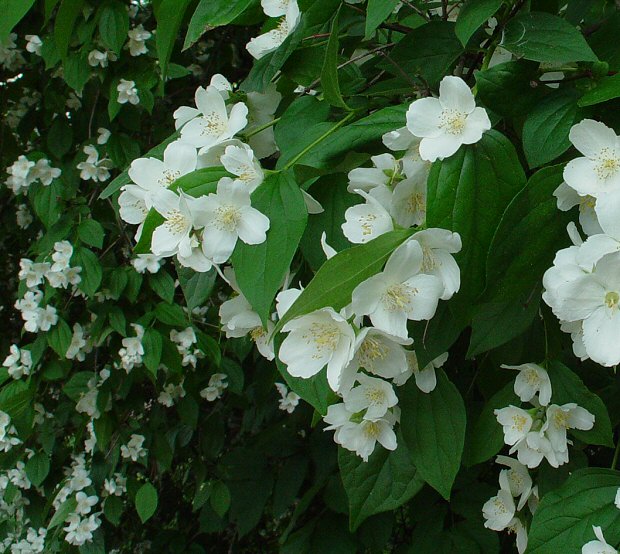Philadelphus pubescens Loisel.
Hoary Mock Orange

Native
CC = 10
CW = 5
MOC = 10
SRank = S1
© DETenaglia
Philadelphus pubescens Loisel.Hoary Mock Orange | |
 |
Native CC = 10 CW = 5 MOC = 10 SRank = S1 |
© DETenaglia |
|
Family - Hydrangeaceae Habit - Shrub to 3 m. Stems - Woody, multiple from base, branching, to 3 m tall. Young twigs somewhat angled, light green to reddish brown, glabrous.
Leaves - Opposite, petiolate. Petioles to 8mm long, pubescent. Blades ovate, with shallow teeth or entire, glabrous or sparsely hairy above, pubescent below, to 8cm long, 6cm broad, acute. Main venation curving towards tip of leaf and not ending at margins. Leaves of flowering branches smaller.
Inflorescence - Terminal panicles of 3-9 flowers. Pedicels to 7mm long, pubescent. Flowers - Corolla to +/-3cm broad, rotate, fragrant. Petals 4 (or 5), white, glabrous, spreading, free, obtue to emarginate at apex, 1.6cm long, +/-1cm broad. Stamens many(+30), erect. Filaments white, to 7mm long, glabrous. Anthers yellow-brown, 1.5mm long. Styles 5, basally connate for 3mm. Stigmas yellow, flattened. Ovary inferior, 4-locular. Placentation axile. Ovules (seeds) many. Hypanthium to 4mm long, lanate. Sepals 4 or 5, 6mm long, 3-4mm broad at base, typically apiculate, lanate, persistent in fruit, spreading.
Flowering - April - May. Habitat - Wooded slopes, rich woods. Origin - Native to the U.S. Lookalikes - Other species of Philadelphus; Rhodotypos scandens. Other info. - This species is not common growing wild in Missouri, but is cultivated. The wild plants are listed as endangered and are from the extreme southwestern portion of the state in McDonald County. It is not that the plant is rare, it is probably just at the extreme edge of its natural range here in Missouri. Photographs taken off College St., Columbia, MO., 5-20-04. |